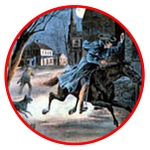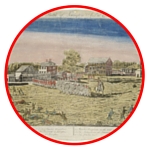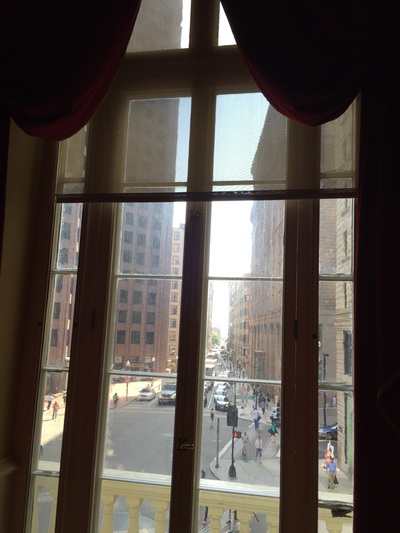The Boston Massacre - March 5, 1770
|
The place to be if you lived in Boston in the 1760's and 70's was the area of King Street in front of The Old Massachusetts State House. Official proclamations were read from the Old State House balcony, on the east side of the building, looking down State (formerly King) Street to Long Wharf. Long Wharf was the city's most active wharf, and the center of commerce in colonial Boston. Businessmen, artisans, merchants, doctors, lawyers, shipbuilders and aristocrats mixed as they bartered their goods and gathered information. It was also where customs commissioners collected taxes, and colonists like Samuel Adams, John Hancock, Paul Revere and others protested those taxes.
The State House was also the meeting place of the Massachusetts Assembly, the first colonial assembly to formally resist British taxation with their letter to parliament asking to overturn the taxes forced on the colonies and allow them to continue to enjoy the same "privileges" that they and other colony assemblies had enjoyed, that only they had as local assemblies elected by colonists had the right to tax them. This was a right to tax that several other local assemblies had as well, as written into charters of many colonies. (footnote ) |
|
Title: A view of part of the town of Boston in New-England and Brittish[sic] ships of war landing their troops! 1768
Author: Revere, Paul
Publisher: Sewell, Alfred L.
Date: 1770, 1870
Location: Boston (Mass.), Boston Harbor (Mass.), Long Wharf (Boston, Mass.)
Author: Revere, Paul
Publisher: Sewell, Alfred L.
Date: 1770, 1870
Location: Boston (Mass.), Boston Harbor (Mass.), Long Wharf (Boston, Mass.)
It was in the middle of all the political and commercial turmoil that Paul Revere produced the engraving above, depicting the arrival of British Troops in September, 1768 at Long Wharf. With tension already high in the small isolated peninsula town, the addition of British troops seems only to have provoked British Soldiers and Bostonians further. On March 5, 1770, a handful of British soldiers fired into a taunting crowd, killing five men.
Revere's engraving, "The Bloody Massacre in King-Street", illustrates the precise location of events, in front of the Old State House. The engraving, was produced just three weeks after the actual event and became an immediate primary source of information for the public about what happened. Yet, there are many inaccuracies and embellishments that cause one to wonder what the true intent of creating the illustrations may have been. Note that by 1770, Revere was also well-known for producing many other illustrations mocking British colonial policies. He was a member of the Sons of Liberty and an influential supporter of the patriot cause. In addition to the engraving, Revere also produced the drawing on the bottom left, which was used at the British soldiers' eventual trial in October of 1770. Precisely diagramming the buildings on King Street in front of the State House and the location of the bodies as they lay in the streets, the "sketch" of the aftermath of the massacre added to the contradictions in the actual testimonies given by both side at the trial.
Revere's engraving, "The Bloody Massacre in King-Street", illustrates the precise location of events, in front of the Old State House. The engraving, was produced just three weeks after the actual event and became an immediate primary source of information for the public about what happened. Yet, there are many inaccuracies and embellishments that cause one to wonder what the true intent of creating the illustrations may have been. Note that by 1770, Revere was also well-known for producing many other illustrations mocking British colonial policies. He was a member of the Sons of Liberty and an influential supporter of the patriot cause. In addition to the engraving, Revere also produced the drawing on the bottom left, which was used at the British soldiers' eventual trial in October of 1770. Precisely diagramming the buildings on King Street in front of the State House and the location of the bodies as they lay in the streets, the "sketch" of the aftermath of the massacre added to the contradictions in the actual testimonies given by both side at the trial.
How does Revere's engraving and "sketch" tell the story? Do you think it is all truth or some propaganda?
|
Paul Revere (1734-1818)
The Bloody Massacre Perpetrated in King Street Boston on March 5th 1770 by a Party of the 29th Reg[imen]t https://www.leventhalmap.org/wp-content/uploads/2018/06/010.jpg |
Paul Revere (1734-1818)
[Autograph Manuscript Drawing of the Boston Massacre] [Boston], 1770. https://collections.leventhalmap.org/search/commonwealth:vh53x374w |














